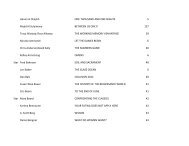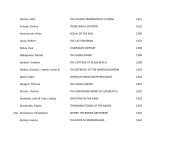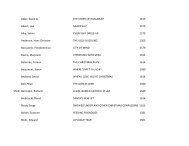nonfiction
nonfiction
nonfiction
You also want an ePaper? Increase the reach of your titles
YUMPU automatically turns print PDFs into web optimized ePapers that Google loves.
“Makers of a series of these models, whether they were<br />
constructed as a school project or just for fun, will come away<br />
with a heightened understanding of aerodynamic principles.”<br />
from the flying machine book<br />
THE CLASSROOM<br />
The Epic Documentary<br />
of a Not-Yet-Epic Kid<br />
Mellom, Robin<br />
Illus. by Gilpin, Stephen<br />
Disney Hyperion (288 pp.)<br />
$12.99 | Jun. 19, 2012<br />
978-1-4231-5063-3<br />
A documentary crew descends upon<br />
Westside Middle School to reveal what<br />
middle-school students’ lives are really like.<br />
At the heart of the story is Trevor Jones, just starting middle<br />
school. He’s a worrier and a “pre-thinker,” and, despite his claim that<br />
he’s not worried about seventh grade, he has it all planned. He’s got<br />
brand-new clothes, and his yogurt stick is frozen just right to be the<br />
perfect temperature by lunchtime. Unfortunately, his best friend<br />
forever, Libby, shakes his cool at the bus stop when she informs him<br />
about the upcoming dance and how he must ask a girl by the end of<br />
the day. The whole novel revolves around the dance and the attendant<br />
social drama of middle-school life. Though readers never find<br />
out much about the making of the documentary itself, it’s a clever<br />
contrivance. A third-person narration alternates with interviews<br />
with the major players. There’s Trevor, Libby, eighth-grader Corey<br />
Long, Wilson the custodian, and seventh-grade gossip Cindy Applegate<br />
among the several main players. Illustrations add appeal to the<br />
story, including cartoonish drawings found in Trevor’s notebook, a<br />
“Social Skills Training” pamphlet found in Counselor Plimp’s office<br />
and drawings from Libby’s Hola! Kitty Cat! sketchpad.<br />
All in all, a silly but appealing story for readers approaching<br />
the middle-school years. (Fiction. 9-12)<br />
THE FLYING MACHINE BOOK<br />
Build and Launch<br />
35 Rockets, Gliders,<br />
Helicopters,<br />
Boomerangs, and Moore<br />
Mercer, Bobby<br />
Photos by Mercer, Bobby<br />
Chicago Review (224 pp.)<br />
$14.95 paperback | May 1, 2012<br />
978-1-61374-086-6<br />
Step-by-step instructions for 35 aerodynamic projects offer hours<br />
of fun and an increased understanding of what makes things fly.<br />
Physics teacher Mercer, who described science principles<br />
in sports in The Leaping, Sliding, Sprinting, Riding Science Book<br />
(2006) here provides clear directions for building a variety of<br />
flying machines including rockets, gliders, helicopters, boomerangs<br />
and assorted launchers. An opening chapter called “Flight<br />
School” introduces the Bernoulli principle and four forces: lift,<br />
thrust, drag and weight. The author’s teaching background is<br />
reflected in his artful use of repetition. Each subsequent chapter<br />
begins with more flight school, repeating the relevant principles<br />
and applying them to the different forms of flying machines<br />
described. Many of the constructions use similar techniques and<br />
most are not difficult. The models are made of common materials:<br />
card stock and old folders, drinking straws, rubber bands<br />
and duct tape. Black-and-white photographs by the author show<br />
hand positions and paper folds, making the steps easy to follow.<br />
He recommends customary safety precautions and periodically<br />
reminds readers that some things may take practice. Makers of a<br />
series of these models, whether they were constructed as a school<br />
project or just for fun, will come away with a heightened understanding<br />
of aerodynamic principles.<br />
Hands-on activities that encourage imaginations to<br />
soar. (Nonfiction. 8-14)<br />
WICKED SWEET<br />
Merrell, Mar’ce<br />
Feiwel & Friends (336 pp.)<br />
$16.99 | Jun. 5, 2012<br />
978-0-312-60749-4<br />
Best friends Chantal and Jillian have<br />
always been on the same page, taking AP<br />
classes and planning for their future as neurosurgeons,<br />
but everything changes during<br />
the summer before their senior year.<br />
When popular Parker begins paying<br />
attention to Jillian, introverted Chantal feels left out. Jillian<br />
cannot understand why wearing a bikini or wanting to go to<br />
parties is suddenly grounds for ending their friendship. When<br />
Parker’s best friend, Will, who normally lives to torment Chantal,<br />
starts trying to hang out with her, Chantal begins to suspect<br />
that there is something bigger going on. Determined to expose<br />
the boys’ scheme, she invents a complicated plan that combines<br />
her newfound love of baking, her intense focus and a whole lot<br />
of sneaking around. More than just a foodie romance, Merrell’s<br />
debut tackles difficult issues such as parental neglect and bullying.<br />
An overly convoluted plot that never gains momentum<br />
overshadows the well-drawn main characters, though. Sweet<br />
confections with clever names brighten the narrative, but they<br />
will not be enough to keep readers’ attention. Predictable secondary<br />
characters and wince-worthy missteps of purple prose<br />
will make readers yearn for more hearty sustenance.<br />
A recipe that never comes together. (Fiction. 14 & up)<br />
ZACH APOLOGIZES<br />
Mulcahy, William<br />
Illus. by McKee, Darren<br />
Free Spirit (32 pp.)<br />
$12.99 | May 1, 2012<br />
978-1-57542-389-0<br />
Series: Zach Rules,<br />
Counselor and psychotherapist Mulcahy makes his children’s-book<br />
debut with the Zach Rules series, designed to give<br />
kids some coping tools for working through everyday problems.<br />
In this series kickoff, Zach’s mother teaches him the foursquare<br />
apology. Zach writes and draws the answers to four<br />
questions (What did I do to hurt someone How did the person<br />
feel What could I do next time How will I make it up to them),<br />
then uses them to make an apology to his sibling for pushing him<br />
down. In the simultaneously publishing Zach Gets Frustrated, a day<br />
at the beach is not much fun for Zach because his kite won’t fly.<br />
By teaching him the three parts of the frustration triangle, his<br />
dad is able to get Zach to name the cause of his frustration, calm<br />
down and reframe the situation. Extensive backmatter in each<br />
book helps parents understand why teaching children these strategies<br />
is so important, as well as how to teach them successfully.<br />
As in many expressly didactic books, interactions between the<br />
characters are stiff and stilted, although Zach’s feelings are widely<br />
recognizable and will be familiar to readers. McKee’s brightly colored<br />
digital illustrations have a Cartoon Network feel to them,<br />
but they nonetheless do a good job of supporting the text and<br />
helping to teach the material.<br />
While not many kids are likely to ask for repeated readings,<br />
still this new series is a useful tool for teaching valuable<br />
skills. (Picture book. 4-8)<br />
RUN THE GAME<br />
Myers, Jason<br />
Simon Pulse/Simon &<br />
Schuster (544 pp.)<br />
$16.99 | paper $9.99 | Jun. 12, 2012<br />
978-1-4424-4627-4<br />
978-1-4424-1432-7 paperback<br />
A 19-year-old junkie with delusions<br />
of grandeur falls for a 14-year-old prostitute<br />
in this poor approximation of a<br />
Chuck Palahniuk novel.<br />
Drug addict and punk guitarist Alexander spends his days<br />
in a depressed Midwestern town drinking enough alcohol and<br />
smoking and shooting enough drugs to put down a bull elephant.<br />
Still, he manages to show up to band practice on time and woo<br />
Patti, a mullet-headed, song-writing Lolita whose motives are<br />
suspect from page one. Alexander believes that he and Patti<br />
will run away to New York and live druggily ever after. But after<br />
Patti’s drug dealer/pimp threatens to chop off his limbs with<br />
a chain saw and leave him to “these four rabid badgers that I<br />
keep… in a shack,” he has second thoughts. It’s written like a<br />
bad rap song; readers will have four-letter-word fatigue within<br />
the first 20 pages—and there are still nearly 500 to go. The<br />
characters are flat, the constant drug use gratuitous and the<br />
graphic, occasionally violent sex scenes pornographic. By the<br />
time the author commits the cardinal sin of plugging one of his<br />
own previous titles within the text, readers will be too numb to<br />
care. Teens looking for gritty content are better off checking<br />
out the award-winning work of Adam Rapp or Ellen Hopkins.<br />
Dreadful. (Fiction. 16 & up)<br />
JUST WRITE<br />
Here’s How<br />
Myers, Walter Dean<br />
Collins (176 pp.)<br />
$17.99 | paper $7.99 | $6.99 e-book<br />
Apr. 24, 2012<br />
978-0-06-220389-2<br />
978-0-06-220390-8 paperback<br />
978-0-06-220391-5 e-book<br />
The third National Ambassador for<br />
Young People’s Literature offers a howto<br />
guide for young writing enthusiasts.<br />
Who’s more qualified to write about the craft of writing<br />
than Myers, one of the biggest names in children’s literature<br />
and author of 100 works for young readers Though this volume<br />
is far from flashy, the straightforward, no-nonsense, you-cando-it<br />
tone may well inspire young readers and beginning writers.<br />
Myers tells about his own life and how he became a writer<br />
before moving on to the craft itself, offering advice on structuring<br />
fiction using a six-box outline and <strong>nonfiction</strong> with a four-box<br />
outline. Excerpts from his own notebooks and commentaries<br />
on his work with teen writer Ross Workman (Myers’ collaborator<br />
on the soccer novel Kick, 2011; Workman contributes to the<br />
backmatter) are enlightening, and readers will find themselves<br />
in the presence of a friendly mentor and writing co-conspirator.<br />
Ultimately, since writers draw on their own lives and interests,<br />
this is a writer’s guide to life. Myers advises, “The best way to<br />
find inspiration is just to live your life doing these things that<br />
interest you most…. Pursuing your passions will expand your<br />
world. This will make you a better writer.”<br />
Good advice on the craft of writing from someone who<br />
should know. (writing tips, further reading on writing, about<br />
the author, a list of the author’s books) (Nonfiction. 14 & up)<br />
ALICE ON BOARD<br />
Naylor, Phyllis Reynolds<br />
Atheneum (288 pp.)<br />
$16.99 | May 22, 2012<br />
978-1-4424-4588-8<br />
Series: The Alice Books, 27<br />
Alice and her friends take summer<br />
jobs aboard a cruise ship on the Chesapeake<br />
Bay following graduation.<br />
Thrilled with the nearly two-to-one<br />
ratio of guys to girls that makes up for<br />
the low pay and drudgery of galley duty, Alice makes the most<br />
of her summer before college. She’s torn between missing Patrick,<br />
who’s in Barcelona, and enjoying flirtatious outings with<br />
Mitch, a 20-ish crew member who’s taking the summer off from<br />
trapping muskrats in the Maryland marshes. Dramatic episodes<br />
large and small fill the weeks on the refurbished Seascape. A passenger<br />
accuses Alice of stealing her watch; another gets his<br />
kicks exposing himself when she comes to clean his room. A<br />
bee sting lands Liz in the hospital; Gwen breaks up with Austin<br />
864 | 15 april 2012 | children’s & teen | kirkusreviews.com |<br />
| kirkusreviews.com | children’s & teen | 15 april 2012 | 865






